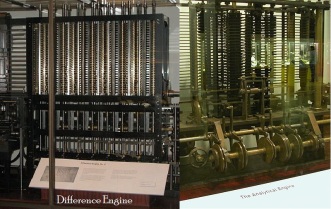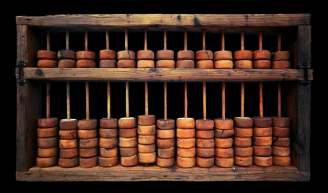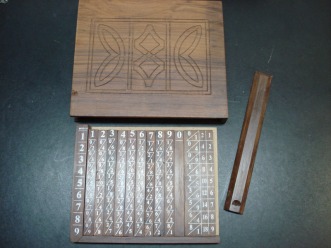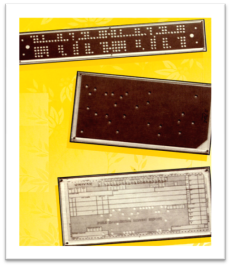The History of Computer started in a calculating device to help everyone in counting large numbers. On which, this devices are used for adding, subtracting, multiplying and some other mathematical operations.
Bellow, are the list of devices invented and used way back, since the ancient times.
ABACUS
The Abacus was first used in China in 3000 B.C. It is also known as “Abaci” or “Abacuses”. It is made up of wood and beads. The abacus was made to help people keep track of numbers as they do the computing. When the Abacus got popular, it spread from China to many parts of the world and even now, a few people, mostly Chinese are still using the Abacus.
NAPIER’S BONE
The Napier’s Bone was invented by John Napier in 1612. It can perform Multiplication, division and can also extract Square Roots. The Napier’s Bone is written on strips of wood or bones. John Napier’s calculating device got so popular in England and western Europe.
SLIDE RULE
In 1622, the Slide Rule was invented by William Oughtred , an Escopalian minister and Mathematician. The slide rule was made with the ideas based with the inventions of John Napier’s Bone or Napier’s Bone and Edmund Gunters invention of Logarithmic Scale. The first Slide Rule was made with written Logarithms on a wood or Ivory. It became so popular until 1974, when the electronic calculators became more popular.
CALCULATING CLOCK
The Calculating Clock is a Calculating Machine made by Wilhelm Schickard in 1623 by a German Astronomer, mathematician, linguist and a Lutheran Minister. He made this calculating machine to help his good friend Johannes Kepler with astronomical calculations. The Calculating clock is technically the world’s first mechanical calculator built in 1623. The Calculating clock technically, doesnt tell time but a calculating device that can Add, Subtract, Multiply and Divide that is only limited to 6 digits. But while Schickard was in the middle of building the machine a fire broke and destroyed the invention and after it happened, Schickard took the tragedy heavily. So he gave up in completing the Calculating Machine.
PASCALINE
 Pascaline is a mechanical calculating device built by a French Philosopher and Mathematician, Blaise Pascal in 1642. Pascal made the device in order to help his father who is a financial assistant. The Pascaline could directly Add and Subtract and could repeatedly Multiply and Divide
Pascaline is a mechanical calculating device built by a French Philosopher and Mathematician, Blaise Pascal in 1642. Pascal made the device in order to help his father who is a financial assistant. The Pascaline could directly Add and Subtract and could repeatedly Multiply and Divide
LEIBNIZ WHEEL
The Leibniz Wheel was invented by Gottfried Wilhelm Von Leibniz in 1673. And it can perform Multiplication, Division and can extract square roots. The Leibniz wheel is a hand-cranked operating calculator that can only perform simple arithmetical operations.
PUNCHED CARDS
Invented by a French silk weaver, Joseph Jacquard in 1810. Punched cards are paper cards that have holes that were punched by hand or by computers. The holes represent as data and stores information by entering the card through the computer. Jacquard looms, are a series of cards that are weaved together to create a multiple groups of different punched cards.The Jacquard cards were later modifies and evolved into a computing punch cards.
BABBAGE’S ENGINE
 Charles Babbage made 2 classes of engine, Difference Engines and Analytical Engines. In 1821, the Difference Engine 1, is the first complete design for an automatic calculating engine. It is designed to tabulate polynomial functions. The Analytical Engine, is a general-purpose programmable computing engine made by Babbage in 1834. Babbage was not able to complete the construction of the machines until 1940’s due to inadequate funding and conflict with his chief engineer. But Charles Babbage improved the design of Difference Engine 1 and called it Difference Engine 2. The New Difference Engine can calculate a 32-digit numbers and can tabulate polynomials up to 7th order.
Charles Babbage made 2 classes of engine, Difference Engines and Analytical Engines. In 1821, the Difference Engine 1, is the first complete design for an automatic calculating engine. It is designed to tabulate polynomial functions. The Analytical Engine, is a general-purpose programmable computing engine made by Babbage in 1834. Babbage was not able to complete the construction of the machines until 1940’s due to inadequate funding and conflict with his chief engineer. But Charles Babbage improved the design of Difference Engine 1 and called it Difference Engine 2. The New Difference Engine can calculate a 32-digit numbers and can tabulate polynomials up to 7th order.
Each generation of computing device, added a bunch of ideas and information that helped other inventors to move forward and slowly build an even better kind of different computers.






